#but still music theory
Explore tagged Tumblr posts
Text
I was inspired by @corseque's (thank you for your service all these years) analysis on the D'read Koda and Dark Solas Theme. I pulled out my crusty old music theory stuff from a thousand years ago. I was never any good at it, so here are my half-baked observations.
To me, the D'read Koda seems like it might end in a different key than we began, in F minor. The natural G in the vocal line is a note in the scale of Fminor. Although it is also a note in the Bflat minor melodic scale, it would have come bundled with an A natural (raised 7th) rather than an A flat. Particularly coming down the scale, the G natural really pulls me towards F minor as the new key. F is a 5th up from B flat which is a common key progression (classic circle of 5ths). To me that suggests transformation... We have moved somewhere else since we started (Thank you character development)! Musically, it's one of the easiest moves to change the key up a 5th because you only have to change a single note on the scale. BUT, moving down a 4th back to the original key? Slightly trickier. At least I never got the hang of it, but Mozart definitely has a full handle on it, so it's possible to do, and quick, and neat. Symbolic? I think so.
Except!!! Right when the D'read Koda gets really loud, there's a low humming G FLAT!!! And it pulls me right back into Bflat minor (where we started) and makes it feel really unfinished (perks of an imperfect cadence, or, the bare bones skeleton of one). So maybe nothing's changed at all... In terms of chord progression... The baseline of the Lost Elf twinkly chordy bits at the beginning seems to go ok with the D'read Koda bell bits. Mainly because it's mostly just an outline of some chords (with the sustained Fs from the D'read Koda), so there's lots of space for the weird creepy dissonant notes to fill. But it does the job, and quite honestly sounds kind of nice. It even gives us suggestions of cadences and dare I say, phrasing. But that's mostly in Lost Elf and not in D'read Koda, imo.
There's a lot of different textures in D'read Koda, to the point where I have a really hard time even discerning pitches, so that's tough. But I'm really quite bad at this stuff (it's really a miracle that I retained anything). So if someone else wants to give it a go...
#lost elf theme#d'read koda#dragon age#veilguard speculation#music theory#potentially really bad music theory#but still music theory
43 notes
·
View notes
Text
Falsettos Food Theory
Okay so someone asked what this is and I really wanna explain! So the falsettos food theory is that food represents love throughout the Marvin trilogy.
In the show, In Trousers, Marvin is very strict about what kind of food he wants, and he gets very upset when he doesn’t get it imminently or the way he wants. For example, in the song ‘How Marvin Eats his Breakfast” there is the lyric,
“No one looks busy in this kitchen
And my breakfast isn't ready
And my stomach aches.”
This is in reference to that no one at that moment is giving him the love that he wants, and that he aches for it. Later in the song he also says ,
“I don't want miracles from heaven
Just some eggies over spinach over toast
No, I will not apologize!
She should win a prize:
Very best emoting
That girl can't cook”
When he says the first line he doesn’t literally mean he just wants a basic breakfast, he means that he doesn’t want much, he just wants to feel loved. By saving “that girl can’t cook” he doesn’t mean she’s lousy at making food, he means that she doesn’t give him the kind of love that he wants. One of the other ladies says
“maybe she can’t cook, but have you seen her milk a cow?” Implying that sexually she “provides” to Marvin, even if he doesn’t romantically like her (obviously this means nothing, just because they can be sexually active does not mean that it is love).
Another one is in Whizzer Going Down he says,
“he hates my wife
I hate his food”.
He’s saying he hates when Whizzer shows him love because he is not ready to accept the fact that he can be loved and he can love another man.
There are many more references of this in the show In Trousers and if anyone wants to hear them I’ll gladly go into it in another post!!
The ones in Falsettos are even more obvious references to love. In the song Tight Knit Family, Marvin sings,
“We all eat as one
Wife, friend, and son
And I sing out as they cook
I love my tight-knit family
I love the way they cook linguine”
They all eat as one meaning they are all receiving love from one another, even if it isn’t good. The next line being “I sing out as they cook” (singing out meaning to say or shout something loudly, most likely implying the unhealthy relationship he’s in with his family) this line is saying that while they provide him love and what ever he asks, he continues to complain about it.
However, in the next line he says “I love the way they cook linguine” which is a considered normal traditional meal for a lot people. This is showing that he enjoys when they provide him with basic normal love, instead of arguing or disagreeing with him.
Another reference later on in the musical is in the ENTIRETY of the song “This Had Better Come To A Stop”. The first set of unique lyrics though is what I’ll cover.
“Whizzer's supposed to always be here
Making dinner, set to screw
That's what pretty boys should do
Check their hairlines, make the dinner
And love me”
This is saying that Whizzer is supposed to always be at Marvin’s command, loving him and giving himself to Marvin sexually at all times. He mentions making dinner twice in these lyrics, again implying that he doesn’t want Whizzers love unless it’s later in the day once he’s gotten his love from his other family ( breakfast specifically).
Another general reference to food equaling love is Cordelia’s entire character. All she does throughout the show is provide food and such to the characters, this being her giving them constant love. Since Cordelia was giving Marvin so much food (presumably) during the two year gap during intermission, we can assume that her unique and (sometimes) not so great food taught him that he doesn’t always get to choose what to eat, but that he should be greatful someone is cooking for him anyway. I think Cordelia is one of the most amazing characters in the story.
For all of the song “Days Like This” she’s trying to get Whizzer to eat something, meaning she’s trying to share her love with him.
In the song “Jason’s Bar Mitzvah”, Dr. Charlotte says
“She's cooked for some 200 guests
[CORDELIA]
We number not that many
Actually... we're seven”
This shows that she has provided so much love for all of these people, even though there’s only seven. Only a couple lines later, she tries the food Cordelia made, and says that the food “tastes really yummy.” (in the pro shot Trina nods her head to agree).
This is important to me because it shows that Cordelia finally found a way to show/express her love with the rest of the characters, and have them reciprocate it for the first time on stage, showing that they are all at peace and finally love each other.
Just like in trousers there are hundreds of more references in Falsettos so if any of you would like me to go more into it I’d be happy to!
This is all speculation of course, we don’t know if any of this was intentional, buts it’s by far my favorite thing to talk about that’s falsettos related. Hope you enjoyed reading!
#falsettos#falsettos 2016#whizzer brown#marvin falsettos#marvin trilogy#in trousers#broadway#musical theater#musicals#am i crazy#theory#food theory#trina weisenbachfeld#cordelia falsettos#charlotte falsettos#jason falsettos#mendel weisenbachfeld#I love them#they are so special to me#I hope you enjoyed reading this it took me forever to write lol#is this cringe be honest#is this fandom even still alive#i hope so!
252 notes
·
View notes
Text

the new album changed me as a person
#literally have been looping this all week#how is aurora still so underrated#aurora#aurora asknes#what happened to the heart?#aurora music#digital art#illustration#brush theory
254 notes
·
View notes
Text
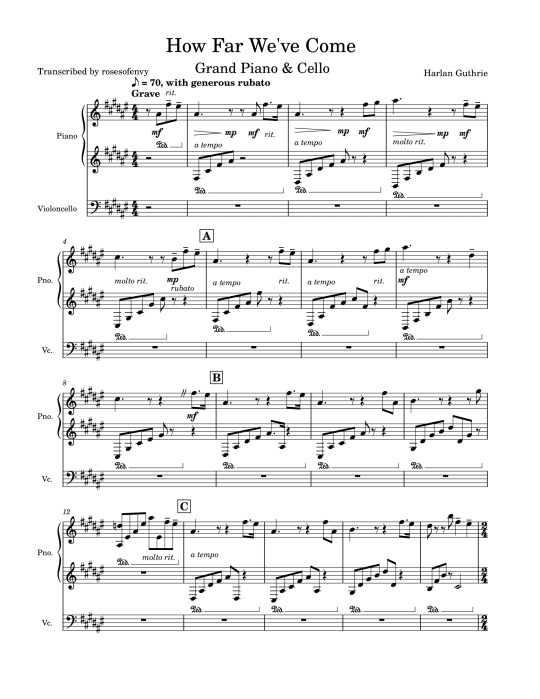

How Far We’ve Come - Music Theory Analysis
[Disclaimer: I went to university for music as a violin primary and have the most confidence with classical strings. I passed my piano proficiency courses, but that is the extent of my piano knowledge. It has been a few years since I have done an in-depth composition analysis of any piece, let alone transcribing a piece by ear and then analyzing it. Music theory has never been my strong suit! Please excuse any mistakes in notation, and any inaccuracies in my transcription or analysis. I did my best and this was purely for fun *shaky thumbs up*]
----------------------
'How Far We’ve Come' by Harlan Guthrie is a duet between Grand Piano and Cello. This piece opens with solo piano, either in a pickup measure or in a single measure of 2/4 before transitioning to 4/4 time in measure 2. Throughout its entirety there are many moments of rubato which have been notated as ritardando and a subsequent a tempo. To most accurately follow the phrasing, listening to the recording is highly recommended.
This piece begins in the key of F#M or the enharmonic spelling of GbM. Although unpleasant to look at with either 6 sharps or 6 flats, depending on which spelling is followed, this key is often used by composers to invoke emotions of a conquest story, evoking relief, triumph, victory, and clarity. As we know from our story in Malevolent so far, this meaning is not lost on us. I have chosen to keep this piece as F#M since that is how I originally began transcribing it. I have also attached the GbM version at the end of the post, however all the analysis follows F#M spelling.
The lone piano begins on the third of our I chord with a hesitant, heavily rubato 8th note pickup into measure 1. The transition from measure to measure in this first phrase gains little confidence, especially with the transition from the pickup into m. 1 as this is the only instance in the piece where the set of 8th notes in the left hand do not lend itself into the next right hand pickup (four 8th notes instead of five). Each lead-in to the downbeat is stretched, pedal held throughout the measure to allow the sound to linger. Each press of the keys is deliberate, yet maintains a mezzo dynamic as the sound fades. m.2 is introduced with a vi chord, creating a hint of unease before resolving in m.3 to a IV(add7). We end our first phrase with a half cadence to a V chord, leading into a V7 as our next phrase begins with a B.
As we enter our second phrase it is similar to our first with m.5 beginning with a I chord, m.6 expands our vi chord compared to its first iteration, resulting in a more confident feel as we continue into m.7 with yet another expansion to our IV(add7). M.8 ends this phrase as we reach another half cadence V chord almost V7.
Beginning m.9 the piece has a few possible paths of analysis, we arrive on a vi chord if we are remaining in F#M, which unlike our other initial starting phrases this throws us into a melancholic mood. There is a possibility of modulation to the relative minor (D#m), however I believe it remains in F#M and utilizes inversions of our chords and will continue with this assumption for the next phrase.
Remaining in F#M, m.10 could be a vi(4/2) inversion, or a I(6/4) inversion. Because Measure 11 moves to a ii chord, I believe it makes more harmonic sense for m.10 to be a vi(4/2) inversion as moving from a I(6/4) - ii is less common than a vi(6/4) to a ii.
M.11 into m.12 is a fascinating progression. We have a V with the (g) in m.11, then we are descending to a Dnat, A#, E# progression. The Dnat is what has thrown me off the most, as it is a minor chord of sorts but doesn’t exist within our key of F#M, or relative D#m. The E# A# progression I believe is a I(4/2) chord, as it is leading us back into the next phrase. Even spelling enharmonically as a A#, Cx, E# chord it does not naturally occur within our existing key. After many hours of checking theory textbooks, writing out possible modulations, and playthroughs of the chords, I’m choosing to leave this as a V-I(4/2) progression and accepting my loss that I do not know what chord exists in the downbeat of m.12. However, I can say that resolving to something that is not a root tonic further creates this sense of melancholy.
Bringing us to our next phrase at m.13, similar to our previous phrase a vi chord but instead of resolving to an A# it resolves to the root D#. M.14 is identical to m.10 with the exception of the lower octave A#3 before resolving in m.15 to a ii chord until the fourth beat of the measure which leads us into measure 16 - resolving to a IV-V half cadence by the end of the measure.
Reaching m.18 we are returning to our original phrase. This is where our cello enters for the duet, in which I have some observations about musicality first. As the piano is using a significant amount of pedal to sustain the sound, the cello utilizes a wide vibrato to create a warm sound. Notably, this doesn’t occur as significantly when entering with the lower notes. The cello is confident, encouraging the piano forward and maintaining a solid momentum even with the hesitance the piano has shown.
M.18 we begin on a I chord, supported by the cello playing a low F# as the root. In the pause between phrases, it's as if you can feel the performers breathing together before they move to m.19, our vi(add7) chord.
Measure 20 I have quite a bit to talk about. Stacked chord analysis is not my forte (pun intended). From what I could hear, there is a B1, F#2, B2, F#3 in the cello, while the piano continues with a IV(add7) chord. B1 is impossible to play on a cello with traditional tuning, in order to achieve this note they would have to tune their lowest string - their C string - down a half step. The chord B1/F#2/B2/F#3 is also impossible to play on a single instrument. If one cello tuned their C down to a B, then they could feasibly play the bottom chord, possibly the two B’s in octaves. It is possible for a cellist to play an F#/B/F# chord, however it would be uncomfortable and not result in a good tonality with it being a triple stop - but, the second cello could split the chord and play a different combination (F#2,B2 or B2,F#) with success. Other solutions to this could be having a double bass play the pedal B, as it would be within their ability on and remain in the correct octave, or having the piano cover the pedal B. This massive chord then resolves simply to a half cadence V chord in measure 21.
Entering our last section, m.22, we return to a phrase similar to the beginning, with a confident I chord. With each measure we go to a more traditional chord progression to a V-IV-V in measures 23, 24, and 25 respectively. In an exciting turn of events, we land on a I chord in our final measure. The first PAC in the entire piece, and yet, it doesn’t sound as if the piece is finished. Throughout its entirety, all the phrases have been a form of inauthentic cadence. We end on a Perfect Authentic Cadence, a V-I, it should sound resolved. And yet, it continues on. The notes ring, and if left on repeat (as I have done for this analysis), it makes sense for it to continue.
In conclusion, I believe this duet is in an general AABBAA format, with A being Major key tonality and B encompassing a minor key tonality. This piece is a conversation, it’s full of emotion and hesitance and is a fantastic representation of everything we’ve seen Arthur and John go through so far in the podcast. I can’t help but think of “I’ve come so far…and I have miles to go before I sleep” with this piece as a reflection of that. This composition is saying “Look, see how far we’ve come, what we’ve done to get here. How we’ve changed and grown.” All this to say, it’s an amazing story and an amazing composition. If you made it this far, I’m glad you came along in this musical journey with me and feel free to add anything I may have missed (or possibly mistaken).
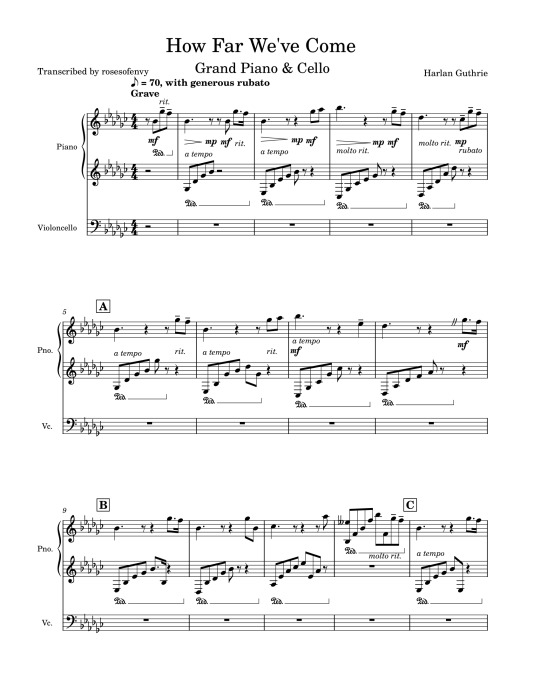
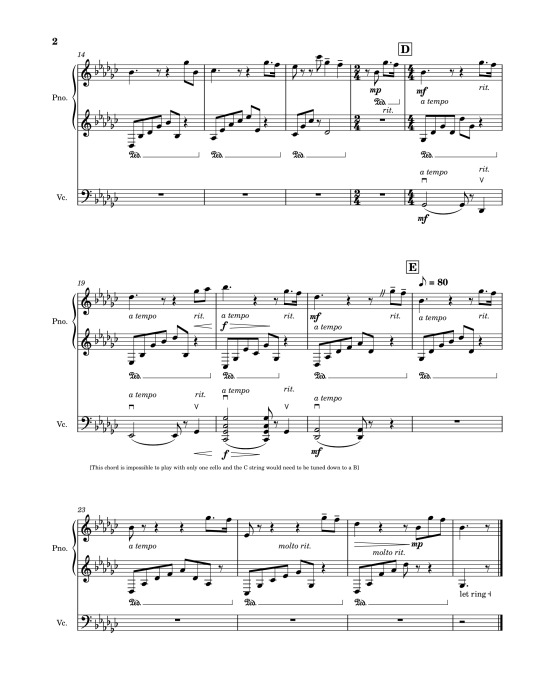
#malevolent#malevolent podcast#malevolent soundtrack#how far we've come#harlan guthrie#arthur lester#john doe#music theory#music theory analysis#piano#cello#I'm working on performing this but I only have access to a piano and cello once a week :'(#and I have so many other projects I've been working on *cries*#i spent a good week transcribing this#then a good two days analyzing it#my music theory chops are rusty#I was seriously pulling out my orchestration and harmony in context textbooks to check my facts#and i'm still worried i made mistakes askljdfhlsa#take all of this with a grain of salt!!!#envy writes
96 notes
·
View notes
Text


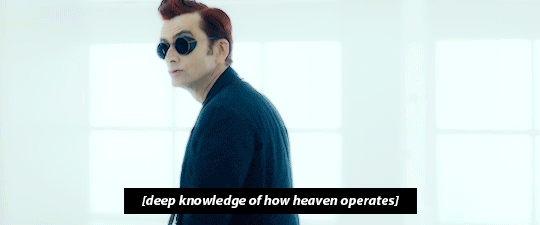

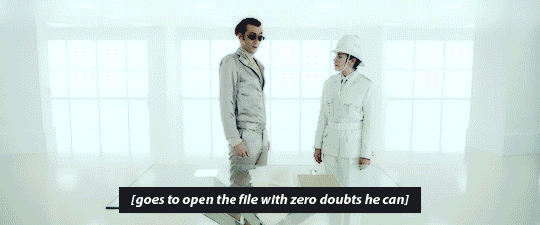
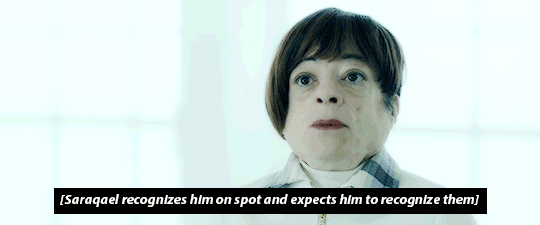
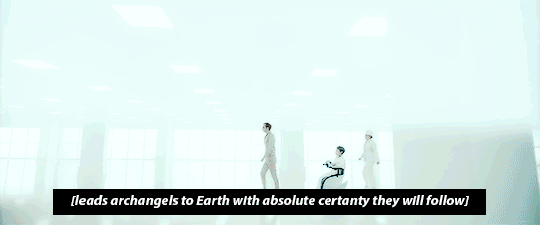

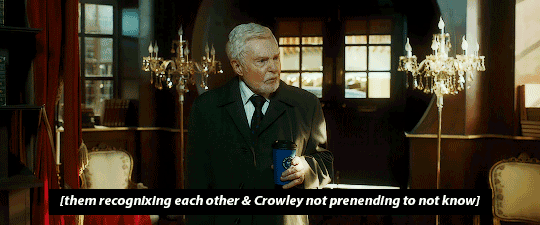
season 2 + nods to 'crowley was raphael' truthers
#personally i quite enjoy being delulu#golden tooth truther here I DO NOT KNOW WHAT IT MEANS BUT I KNOW IT MEANS THINGS.#aLSO. THE PAUSE. WHEN GABRIEL TRIES TO REMEMBER THE NAME. MUSIC SWELLING.#a fakeout if i ever saw one#(you can't) change my mind#and listen i love the 'crowley was a nobody' theory just as much but they threw that one out the window with the file reveal#so.#crowley is lucifer theory is uh fun but i can't get behind it whoops#good omens#crowley#crowley was raphael#good omens 2 spoilers#ok that's too many tags already. if you're still reading PLEASE RECOMMEND ME FICS.#and also if you want a gifset send an ask cause i'm obsessed#also! feel like most of these are from heaven-times. and yeah. more 'crowley in heaven' content @neil gaiman please#crying over the gif quality btw
727 notes
·
View notes
Text
Every phanfic that gives Erik a regular degular job is automatically funny. You mean to tell me the phantom of the opera taught your music theory class? The angel of music wrote your grant proposal? Designed your corporate website? Baked your kid’s birthday cake? Outstanding, incredible, a standing ovation and an annual bonus for this man from the sewers.
#the music theory professor and grant writer are mine though I’m not alone in those either#ofc he was an architect in canon before he went off the deep end but I still lol#phantom of the opera#poto#erik the phantom
187 notes
·
View notes
Note
When you go into a new song what do you listen for from it? The instruments, the vocals, how the guitar or percussion are doing, etc
I'm often grabbed by a strong, unconventional melody, I'm particularly charmed by anything in minor key. I like music that feels layer-y. I like when there's a build up to a more intense part of the song. A lot of the time though what I like in a song is really on a case by case basis! This sort of tugging, swelling feeling in my chest. oh also I love really crunchy grimy bass. and a danceable rhythm (though thats not a requirement).
I love love wistful songs! i love stuff I could listen to on the bus ride home, when it's dark. I love aching or conflicted feelings in a song. I love when a song has voice samples from films
#im just listing some things i like#i know a bit abt music theory but not enough to really sound very intelligent abt it. a lot of my enjoyment of music is abt feelings#also im still tipsy and cant give the most articulate answer anyways#i like good vocals but i dont usually place that much importance on vocals themselves. more just the melody theyre conveying
24 notes
·
View notes
Text
So, in s5 we're going back to s1, right?
In s1 hearing Will sing in the talkie was a beacon of hope. He's alive!
What if in s5 it's the opposite? the moment doubt sets in?
Personally I ain't expecting another "fast! what's their fav song??", but it would be expected for music to be used with a positive driving force. Motivating, inspiring, waking up some good memories.
However, making the villain use the 'good guys' weapon against them?
That's new.
Everyone having a break, occupying some room, Will scribbling in a notebook half-heartedly. Then a head turns in his direction. And then another one. Already faint chats stop mid sentence, one after the other. All noise but one tune die out.
He's humming absentmindedly. A word or two every now and then.
...
"What's that song he's singing?"
"Guys..."
"Will?"
"Where did you hear that song?"
"What song?"
"The one you were just humming?"
The one that was playing on the radio.
"It- It was just playing on the radio?"
...
"...There's no radio here."
And nobody knows if it was just the connection, the memory somehow making it's way into Will's mind or Henry deliberately showing everyone that he's there. He has him.
But then?? Wouldn't it be stupid, losing his spy? Why would he do that, it couldn't have been on purpose!
After that it comes falling apart. Mistrust and doubt. Confusion and chaos.
Well, he played us the last time!
(I am of course talking about Victor's safe song, Dream a little dream of me)
#and the opportunity of breaking the main motive of music being a saving force as a way to crush the character's spirits <333#cause like yeah a song can still break somebody out#but now the idea is tainted#as I am writing this doubt sets in#did nancy and robin find out what Victor was humming?#ig it's the schrödinger's gun this time y'all#maybe i pulled this out of my ass and maybe i did not#as long as i dont check im safe#hahaha chekhov's gun see what i did there#byler#will byers#henry creel#st5 theory#*will standing in the corner* they dont know if im possessed#and neither do i#or do i
39 notes
·
View notes
Text

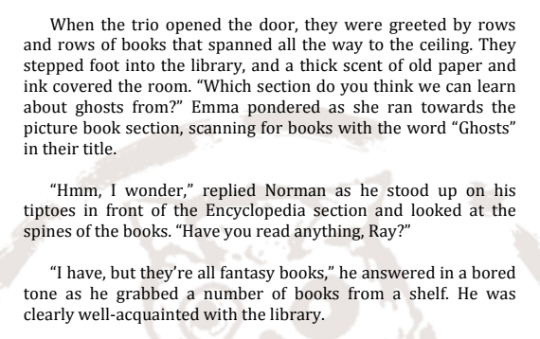
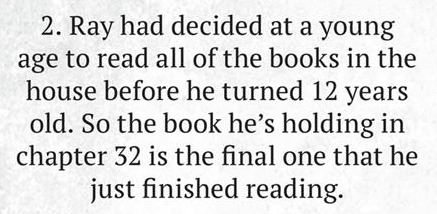

(Chapter 32 | TPN Light Novel 1: A Letter from Norman - "The Ghost Incidents at Grace Field House" | Shirai's Highlights for Volume 4 | Chapter 140 Post)
The most common route I see is he regains his love for it after he's out of the oppressive environment of Grace Field (myself included), but I've also seen some people opt for him to focus more on cooking, photography, machines, or archery.
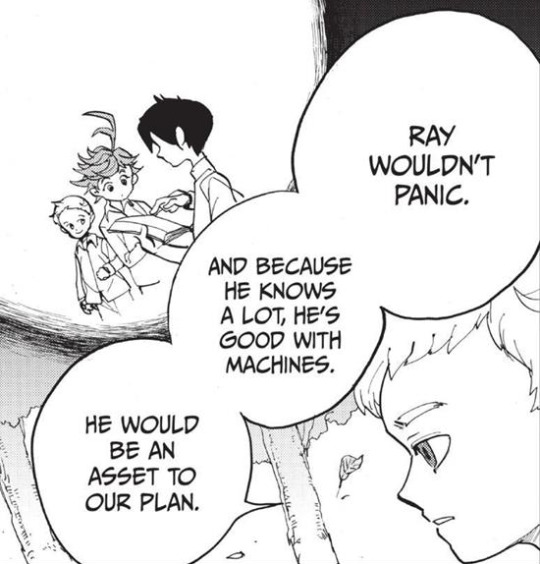


(Chapter 4 | Questionnaire Translation Source | Mystic Code Book Chapter 7 Q&A)
#“favorite leisure activity in theory” if you wish you read more but end up distracted for whatever reason lol#the projection after being burnt out on reading after uni#I have such a soft spot for librarian Ray thanks to sae <3 <3#“Norman likes music normally” is still one of the funniest sentences to come out of the mystic code book#really him liking anything normally like have you seen his dramatic theater-kid ass?? it's 0% or 110% nothing in between#The Promised Neverland#Yakusoku no Neverland#TPN#YnN#TPN Polls#FSS Polls#FSS Shenanigans#TPN Ray#YnN Ray#Ray 81194#Mystic Code Book#TPN Light Novels#A Letter from Norman#The Ghost Incidents at Grace Field House#TPN 004#TPN 032#TPN 140#Introduction Arc#Escape Arc#Seven Walls Arc#Post-Canon#Ray
30 notes
·
View notes
Text
Ok silly Malevolent thinking time -- something that's been floating around my head as someone who's studied a lot of 20th century music history and theory is that there's nooo way Arthur would have become a professional composer in the 1920s. If Faroe's Song is comparable to the rest of Arthur's compositions, his tonal language was just too darn simple for the trends of music at the time. On one hand, swing bands, ragtime, and blues were all the rage in the 20's/30's (George Gershwin, Duke Ellington, Tommy Dorsey, etc.). That's what sold at the time, and it influenced a lot of classical music at the time too -- you could even hear jazz and ragtime inspiration in European music written at the time (e.g. Debussy's Gollywog's Cakewalk from his Children's Corner Suite!). Arthur's music is definitely Not That, though.
On the other hand, you had the rise of the modernist and expressionist movements post WWI, which brought about some crazy composers who did wacky things with harmony and tonality just because they could (think Charles Ives, Amy Beach, Arnold Schoenberg, Maurice Ravel, etc.) and Arthur's music is also definitely Not That either.
Arthur's style reminds me more of contemporary classical music (think Arvo Part/Hans Zimmer esque) that we saw cropping up in the 1970s and later. It's very reminiscent of late 20th century/early 21st century modern film composition still very much in existence nowadays -- they're meant to be simple as to not take attention away from the main piece of media you're watching. Which, from a production perspective, makes a lot of sense for Malevolent, because the music is often used as scoring for whatever's happening in the show! So maybe this is all intentional and this whole post is for nothing! But I just thought it was something worth sharing because it has been on my MIND anytime Arthur or another character brings up his compositions
#malevolent#music history#ok disclaimer its been like a year since i've been in a music history course so give me a break if i'm wrong i did fact check with my notes#music theory#PLEASE DON'T COME AFTER ME ALSO I'm not a Harlan music hater. I just think it's not time-period accurate.#Harlan did a great job with the music there is no doubt about that#It's also difficult to write music within a certain time period if you haven't spent hours studying the specific idioms of that time#so not his fault and I think it still works! just lowkey takes me out of the immersion a bit#does this sound elitist? i'm so sorry if it does
20 notes
·
View notes
Text
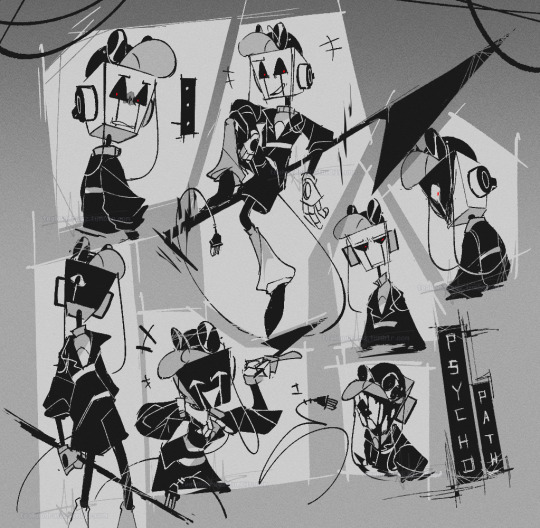
" I'm a Psycho, loving it~ "
#[album]#ask to tag#cw#Music Shot#S-2#also i just wanna mess with its expressions and poses cuz it's fun#he can turn the black face into a screenface. changing any shapes and expressions as it pleases#horror. realistic eyes. tv static. etc but he prefers the original triangle smiles more#also i'm planning to redesign S-2 right now#S-2 focuses only on killing / violence to gain LV and he's stuck that way and called it a purpose to wipe out population#He got so focus on gaining LV because it made him feel so powerful and wanted more feeling like it's the only thing that made him feel aliv#i'm okay to spoil his story and all. He's made out of human determination in Mark's body and became a split personality to him#that's why S-2 and Mark are both corrupted because they're still not compatible to each other in one body#instead of being unstable in physical form. his mind is. because Gaster used a different formula but failed again#Gaster was trying to cure Mark because he was really ill and about to die#I only took the references/theories from the original undertale amalgamation obviously#S-2 was formed from Mark's own negative emotions and personalities then it became its own character#which causes the two (or Mark or S-2 themselves) to self-loathe with each other#it's literally like looking in a window as a mirror talking shit to each other#The real good Mark in this au is Mark himself. he just needs to be set free from this misery (and need to get rid of S-2 if possible)#that's why in my old Mark death posts. S-2 was gone from self-forgiveness meaning Mark forgives himself and deserves to be happy#(because everyone don't deserve to hate themselves)#i'm gonna keep the left eye joke not being available when doing the horror screenface cuz still wanna make it a Mark thing to him#cw horror#cw eye contact
50 notes
·
View notes
Text

My round 7 bingo card
Edit:
Spare square, for there being a flashback to Till and Ivan playing together as kids, Till's running ahead of Ivan (to parallel the running away scene in Black Sorrow), and he turns around and Ivan's either gone or dead.
If this happens, I get to replace any one square with that instead.
#alien stage#alnst#alnst r7#alien stage round 7#r7#round 7#chat i want my queen hyuna to live so bad#but i already forsee it.#hyuna my fav this round will break me#my theory is#mizi comes in with a smoke grenade#round is cut short by it but the music is still going but till isnt singing#the smoke clears#all thats left on stage is luka#“And in a blink Gone” Luka sings when visibility is restored#Luka's been in on it all along#he's just weird#if Luka's not in on it I will continue to dislike him#but considering he didn't snitch on hyuna taking mizi#he may have been in on it all along#but this is a till focused round so
14 notes
·
View notes
Text
Still yearning for the day when my wife (ninjago music spotlight) will come back from the war (release another episode) :,((((
#i swear my brain is stupid and cannot just focus on background music on its own and find reocurring motives unless it already knows that#they exist#but i still absolutely ADORE when the music has a little bit of lietmotives in it. as a treat for the silly little gay folks who are#listening to it. because i am a UT fan through and through. and also SU fan.#and the breakdowns of the music that they did was so fun too :((#very accessible to the average guy who's only now starting to learn about music theory because they didn’t start playing any instrument even#before they went to school (like some cooler folks did). but still incredibly interesting <33333333#ninjago music my beloved <3333#ninjago#lego ninjago#ninjago dragons rising
13 notes
·
View notes
Text
It took me until my second watch to realise this callback / foreshadowing in Twisted




#i almost shouted when i heard the first part on my rewatch#this slso proved my theory that I'd like twisted better on rewatches#its still not my favourite but i appreciate it#twisted#twisted musical#starkid twisted#twisted starkid#starkid#starkid productions#team starkid
56 notes
·
View notes
Text
(wicked spoilers)
Galinda saying "and goodness knows, the wicked die alone" knowing that she was right there when Elphaba died
#my theory is that she doesn't view Elphaba as wicked#which is probably really obvious#but still entertaining to me#wicked the musical#wicked glinda#wicked elphaba#gelphie
25 notes
·
View notes
Text
it must be sad to be someone who can't find and doesn't want to look for the meaning in anything. thinking art is boring, thinking the long, drawn-out semi-abstract explanations musicians and artists give before they show their work is meaningless fake bullshit. it must be such a dull world to live in where one doesn't obsessively examine every word, every note from a work you love to find the beauty and the message and meaning and purpose in every grain of sand that gives it form. how sad.
#bluebird.txt#yes this is a vaguepost no it's not about anyone here at all#but like. curtains are just blue type bitches how does it feel for the world to be so sad and empty?#im out here overanalyzing every word out of a children's movie and finding even the most obvious perhaps of meanings in a certain note#or repeated motif#and it makes everything look wonderful#adds to my appreciation for it for the detail no matter how small or seemingly inconsequential#everything is a choice and some people don't understand that#when art is good it's all about intention#speaking as someone who's working on their art (music) and learning how to make those choices#and even that there are choices i can make bc sometimes im like woah i didn't know i could do that!#and those choices make such a huge difference those tiny choices#anytime you watch something even if the author or composer or whoever didnt think much of a certain choice#they still made it and it still makes it different than it would've been if they'd chosen a different word/chord/color#the world and art can be beautiful. why would you choose to see it so boringly???#truly it boggles the mind#violaposting#this is why i like theory
14 notes
·
View notes